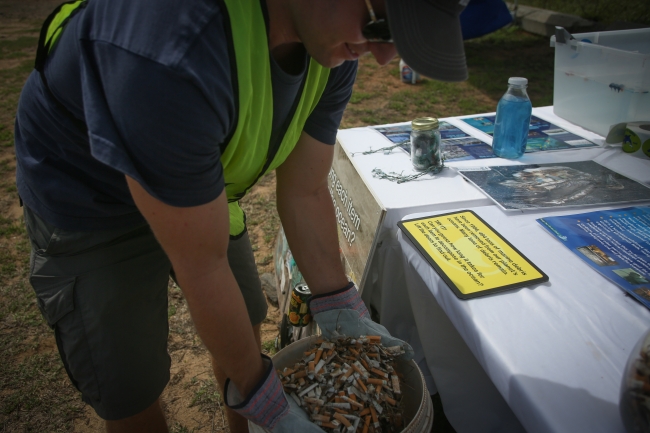Meet Mark Manuel, the NOAA Marine Debris Program’s (MDP’s) Pacific Islands Regional Coordinator! Mark is a Hawaii native, and received his B.S. in Marine Science and M.S. in Tropical Conservation Biology and Environmental Science from the University of Hawai‘i at Hilo. Before joining the MDP, Mark spent six years with the NOAA Pacific Islands Fisheries Science Center, Coral Reef Ecosystem Program. He now works in Honolulu, where he oversees marine debris removal and research projects, the Hawai‘i Nets-to-Energy program, and the NOAA Observer Program at-sea marine debris encounter reports. Mark also works with the Consulate of Japan to confirm tsunami marine debris, is part of numerous emergency response networks, and communicates with the U.S. Coast Guard and state agencies to address Abandoned and Derelict Vessels. Reach out to Mark at mark.manuel@noaa.gov!
Meet Grace Chon, the NOAA Marine Debris Program’s Pacific Islands Assistant Regional Coordinator! Grace was born and raised in Maryland and received her B.S. in Biology at the University of Maryland, College Park. After graduating and living in Venezuela for a year, she headed to Hawai'i Pacific University, where she earned her M.S. in Marine Science. As the Assistant Regional Coordinator, Grace now works in Honolulu, Hawaii, where she focuses on marine debris prevention projects, Hawai'i Marine Debris Action Plan activities, regional outreach efforts, and coordination in the territories. Reach out to Grace at grace.chon@noaa.gov!
The Pacific Islands are full of sun, sand, and unfortunately… marine debris. Like many other coastal areas, the Pacific Islands are not immune to the impacts of marine debris. Due to the Pacific Islands’ position in the Pacific Ocean and in relation to the North Pacific Gyre and ocean currents, they are often inundated with debris from both local and far-off sources. Luckily, there are many great efforts underway to address and prevent marine debris in this area. Check out a couple newly-established projects funded by the NOAA Marine Debris Program:
Preventing marine debris is the ultimate solution to the problem, so Pacific Whale Foundation (PWF) is working to do just that! They’ve launched a public awareness campaign focused on tobacco-free beaches in Maui, Hawaii. To get the word out, they’re creating public service announcements, developing handouts and outreach materials, and giving presentations. PWF is also hosting an art contest to promote marine debris outreach and education. For more on this project, check out the project profile on our website.
Unfortunately, there’s enough marine debris out there that we also must work on removing it. To help clean our shores, Hawai‘i Wildlife Fund is leading an effort to remove as much debris as possible from over 200 miles of coastline on four different islands in Hawaii! Engaging hundreds of volunteers, they aim to remove approximately 55 metric tons (about 120,000 pounds) of marine debris! For more on this project, check out the project profile on our website.

There are lots of cool things going on in the Pacific Islands! Keep your eye on our blog this week for more, and check out our website for more interesting marine debris projects in the Pacific Islands and throughout the country!


